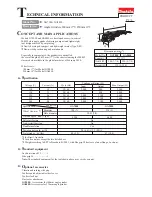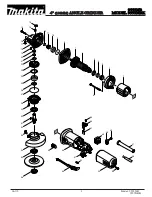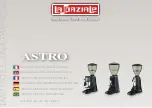
10
Thread wire cup brush / wire bevel brush onto spindle
and tighten with supplied wrench. When using brush,
avoid applying too much pressure which causes over
bending of wires, leading to premature breakage.
Operation with abrasive cut-off /
diamond wheel (optional accessory)
Fig.18
The direction for mounting the lock nut and the inner
flange varies by wheel thickness.
Refer to the table below.
22.23 mm (7/8")
Abrasive cut-off wheel
Diamond wheel
Thickness: Less than
4 mm (5/32")
Thickness: 4 mm (5/32")
or more
Thickness: Less than
4 mm (5/32")
Thickness: 4 mm (5/32")
or more
22.23 mm (7/8")
22.23 mm (7/8")
22.23 mm (7/8")
150 mm (6")
1
2
3
1
4
3
3.
2.
Inner flange
1.
Abrasive cut-off wheel
Diamond wheel
Lock nut
4.
011073
WARNING:
•
When using an abrasive cut-off / diamond wheel,
be sure to use only the special wheel guard
designed for use with cut-off wheels. (In some
European countries, when using a diamond wheel,
the ordinary guard can be used. Follow the
regulations in your country.)
•
NEVER use cut-off wheel for side grinding.
•
Do not "jam" the wheel or apply excessive
pressure. Do not attempt to make an excessive
depth of cut. Overstressing the wheel increases
the loading and susceptibility to twisting or binding
of the wheel in the cut and the possibility of
kickback, wheel breakage and overheating of the
motor may occur.
•
Do not start the cutting operation in the workpiece.
Let the wheel reach full speed and carefully enter
into the cut moving the tool forward over the
workpiece surface. The wheel may bind, walk up
or kickback if the power tool is started in the
workpiece.
•
During cutting operations, never change the angle
of the wheel. Placing side pressure on the cut-off
wheel (as in grinding) will cause the wheel to crack
and break, causing serious personal injury.
•
A diamond wheel shall be operated perpendicular
to the material being cut.
MAINTENANCE
CAUTION:
•
Always be sure that the tool is switched off and
unplugged before attempting to perform inspection
or maintenance.
•
Never use gasoline, benzine, thinner, alcohol or
the like. Discoloration, deformation or cracks may
result.
Fig.19
The tool and its air vents have to be kept clean.
Regularly clean the tool's air vents or whenever the
vents start to become obstructed.
To maintain product SAFETY and RELIABILITY, repairs,
carbon brush inspection and replacement, any other
maintenance or adjustment should be performed by
Makita Authorized Service Centers, always using Makita
replacement parts.











































